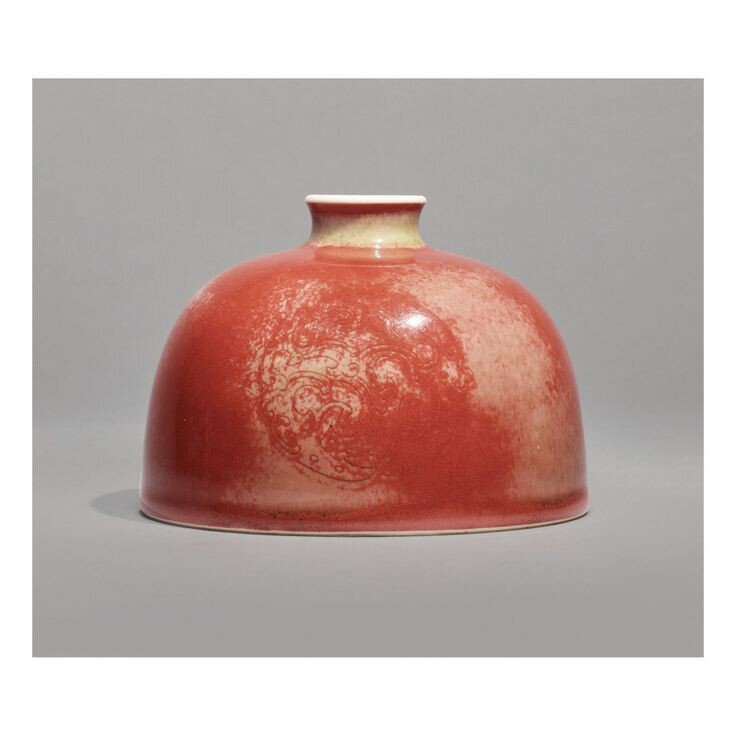A peachblop-glazed 'beehive' waterpot, Kangxi mark and period (1662-1722)
Lot 115. A peachblop-glazed 'beehive' waterpot, Kangxi mark and period (1662-1722); Diameter 5 in., 12.7 cm. Estimate: 60,000 - 80,000 USD. (C) 2020 Sotheby's
of classic domed taibai zun form, the tapering sides rising to a rounded shoulder and a short waisted neck below a lipped mouth-rim, the sides delicately incised with three stylized archaistic dragon roundels, the exterior applied with a vivid crimson-red glaze transmuting to a beige-pink mottled with raspberry-tinged flecks imitating the skin of a ripening peach, the neck with a green-flecked, mushroom-beige concentration, the countersunk base inscribed with an underglaze-blue six-character mark in three columns.
Exhibited: Exhibition of Ancient Chinese Ceramics from the Collection of the Kau Chi Society of Chinese Art, Art Gallery, The Chinese University of Hong Kong, Hong Kong, 1981, cat. no. 127.
Zhongguo mingtao riben xunhui zhan. Gangtai mingjia shoucang taoci jingpin [Exhibition of Famous Chinese Ceramics Touring Japan. Fine Ceramics from Private Hong Kong and Taiwanese Collections], Nihonbashi Takashimaya, Tokyo, 1992, p. 167.
Note: 'Peachbloom’ waterpots of this characteristic form are known as taibai zun, after the Tang dynasty (618-907) poet Li Taibai (701-762). A notorious drinker, he is often depicted leaning against a wine jar of this form, as seen in a porcelain sculpture of the same period, in the Palace Museum, Beijing, illustrated in Kangxi, Yongzheng, Qianlong. Qing Porcelain from the Palace Museum Collection, Hong Kong, 1989, p. 106, pl. 89. While this form is commonly described as a waterpot, its intended use is difficult to identify, as noted by Regina Krahl in ‘Peachbloom’, Chinese Porcelain from the 15th to the 18th Century, Eskenazi, London, 2006, p. 10. It is imagined that vessels of this type were filled with water to allow a painter to dip their brush and then shape it on the neck. However, Chinese painters typically dip their brush directly into the ink, previously prepared by grinding an ink cake with a few drops of water.
Similar waterpots include one in the Palace Museum, Beijing, illustrated op. cit., p. 142, pl. 125; another in the Shanghai Museum, published in Wang Qingzheng, ed., Kangxi Porcelain Wares from the Shanghai Museum Collection, Hong Kong, 1998, pl. 206; a third from the Sir Percival David Collection and now in the British Museum, London, included in Illustrated Catalogue of Ming and Qing Monochrome Wares, London, 1989, no. 580 and on the cover; and a further example from the collections of Edward T. Chow and the British Rail Pension Fund, sold twice in our Hong Kong rooms, 25th November 1980, lot 66, and again 16th May 1989, lot 61.
Sotheby's. Kangxi Porcelain - A Private Collection. Live Auction: 22 September 2020 • 3:00 PM CEST • New York.

/https%3A%2F%2Fprofilepics.canalblog.com%2Fprofilepics%2F1%2F0%2F100183.jpg)
/https%3A%2F%2Fstorage.canalblog.com%2F03%2F02%2F119589%2F96711876_o.jpg)
/https%3A%2F%2Fstorage.canalblog.com%2F11%2F31%2F119589%2F94773502_o.jpg)
/https%3A%2F%2Fstorage.canalblog.com%2F20%2F83%2F119589%2F94772815_o.jpg)
/https%3A%2F%2Fstorage.canalblog.com%2F26%2F72%2F119589%2F75604929_o.jpg)
/https%3A%2F%2Fstorage.canalblog.com%2F59%2F60%2F119589%2F26458628_o.jpg)





/image%2F1371349%2F20240425%2Fob_c453b7_439605604-1657274835042529-47869416345.jpg)
/image%2F1371349%2F20240425%2Fob_59c6f0_440358655-1657722021664477-71089985267.jpg)
/image%2F1371349%2F20240425%2Fob_07a28e_440353390-1657720444997968-29046181244.jpg)
/image%2F1371349%2F20240425%2Fob_0b83fb_440387817-1657715464998466-20094023921.jpg)